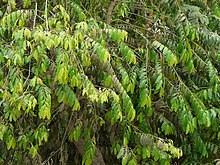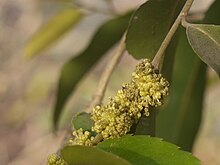Putranjivaceae
| Putranjivaceae | |
|---|---|
 | |
 | |
| Putranjiva roxburghii | |
| Scientific classification | |
| Kingdom: | Plantae |
| Clade: | Tracheophytes |
| Clade: | Angiosperms |
| Clade: | Eudicots |
| Clade: | Rosids |
| Order: | Malpighiales |
| Family: | Putranjivaceae Endl.[1] |
| Genera | |
| |
Putranjivaceae is a rosid family that is composed of 218 species in 2 genera of evergreen tropical trees that are found mainly in the Old World tropics, but with a few species in tropical America.[2][3]
Members of this family have 2-ranked[clarification needed] coriaceous leaves, which, if fresh, typically have a radish-like or peppery taste. The flowers are fasciculate and usually small, and the fruits of these species are a single-seeded drupe crown by the persistent stigmas. This family has its origin in Africa and Malesia. It is the only family outside Brassicales that produces mustard oils.
Taxonomy
This family was formerly a tribe (Drypeteae) of the subfamily Phyllanthoideae in the Euphorbiaceae. When the Phyllanthoideae was separated to form the new family Phyllanthaceae, it was decided that the former Drypeteae would also stand alone, with the status of a family: Putranjivaceae.
References

- ^ Angiosperm Phylogeny Group (2009). "An update of the Angiosperm Phylogeny Group classification for the orders and families of flowering plants: APG III". Botanical Journal of the Linnean Society. 161 (2): 105–121. doi:10.1111/j.1095-8339.2009.00996.x. hdl:10654/18083. Archived from the original (PDF) on 2017-05-25. Retrieved 2013-06-26.
- ^ Christenhusz, M. J. M.; Byng, J. W. (2016). "The number of known plants species in the world and its annual increase". Phytotaxa. 261 (3). Magnolia Press: 201–217. doi:10.11646/phytotaxa.261.3.1.
- ^ "Putranjivaceae Endl. ex Meisn. | Plants of the World Online | Kew Science". Plants of the World Online. Retrieved 2020-02-03.
- Encyclopædia Britannica Online
- v
- t
- e
- Supergroup Plant:
- Bryophyta
- Marchantiophyta
- Polypodiophyta
- Acrogymnospermae
- Angiospermae
| Amborellales | |
|---|---|
| Nymphaeales | |
| Austrobaileyales |
 Category
Category
 | This Malpighiales article is a stub. You can help Wikipedia by expanding it. |
- v
- t
- e












